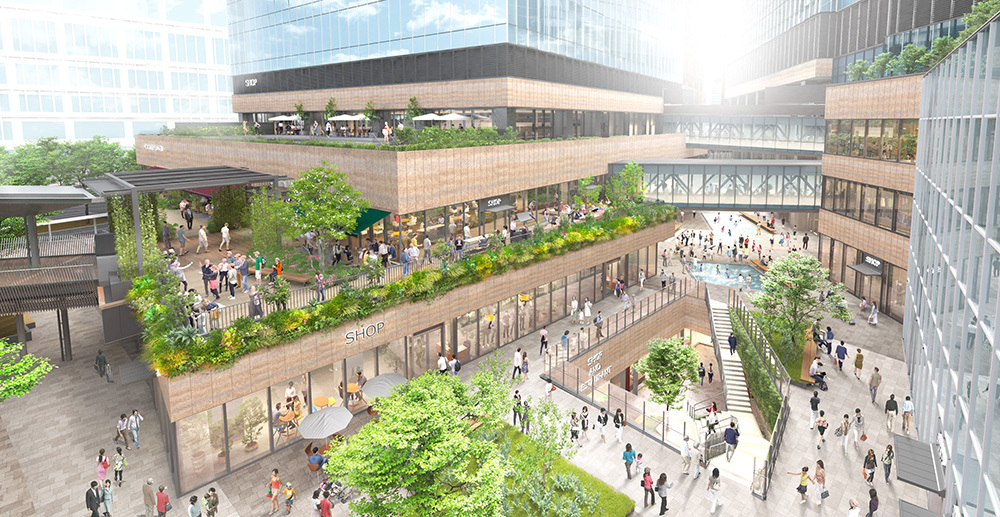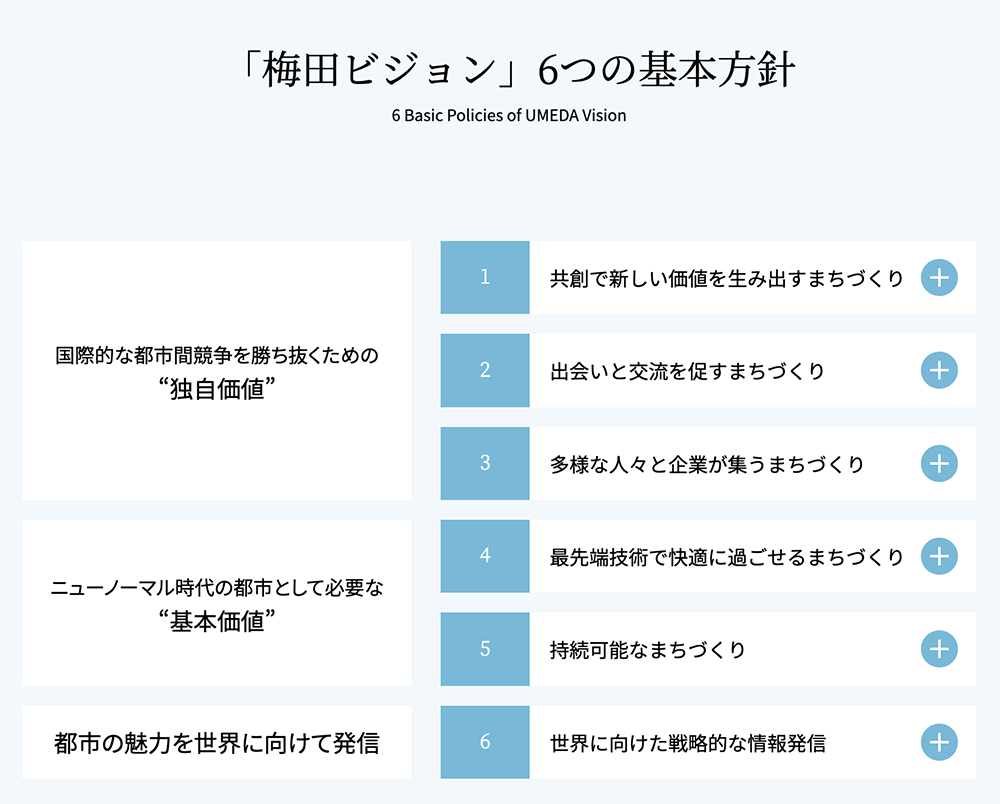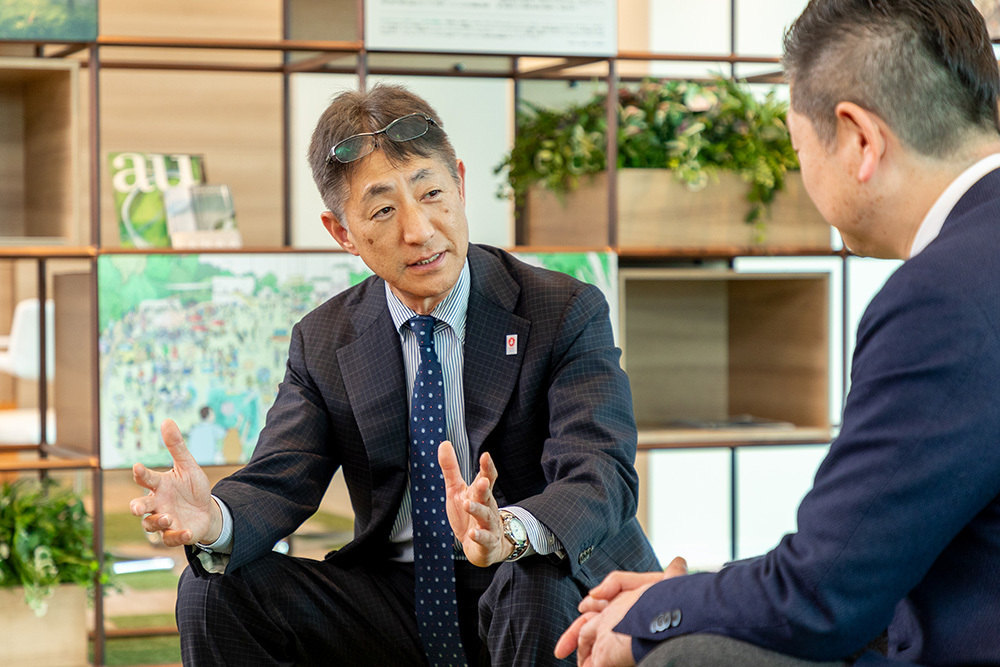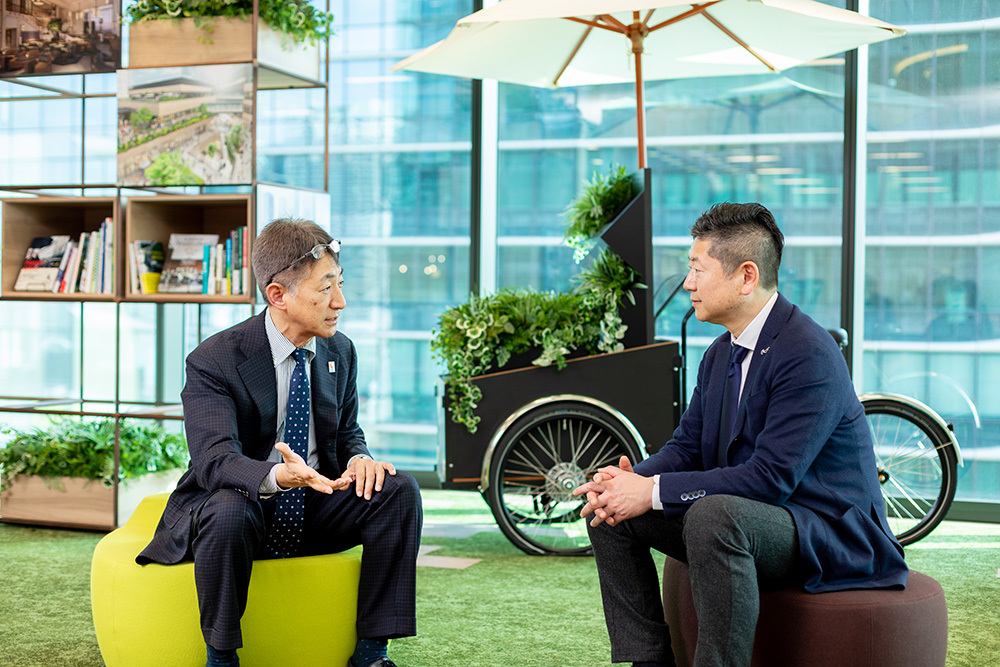Note: This website was automatically translated, so some terms or nuances may not be completely accurate.
It's not just about convenience! What are the two aspects that bring out the charm of Osaka's Umeda district?

Tanihiko Taniguchi
Hankyu Hanshin Properties Inc.

Takuji Ichiyama
Dentsu Inc.
Dentsu Inc.'s 'Urban Future Design Unit' is a specialized team that envisions the future of cities and lifestyles, providing support across various fields from conception to realization ( details here ).
This series has explored, from various angles, what is required for future urban and community development, as well as what makes cities with high levels of happiness.
This installment focuses on Osaka's Umeda district, undergoing major transformation with new commercial facilities and office buildings opening one after another. Dentsu Inc.'s Takuji Ichiyama interviewed Akihiko Taniguchi, Director of Hankyu Hanshin Properties, who announced the "Umeda Vision" concept in 2022 to enhance the district's value. Under this vision, Taniguchi is leading unique urban development that leverages both a global perspective and local characteristics. They discussed how to create new value in Umeda's urban development and shared insights on achieving it.

<Table of Contents>
▼Formulating the "Umeda Vision" to Share Urban Development Guidelines
▼Creating a New Hub for Startups and Business Innovation!
▼What Are the Core and Fringe Elements Enhancing Umeda's Appeal?
▼Our Strength Lies in Urban Development and Community Building Centered on Public Transportation
Formulating the "Umeda Vision" to Share Community Development Guidelines
Kazuyama: The redevelopment of the "Umeda Area," the former freight station site north of JR Osaka Station, is a major project attracting attention from various quarters. First, could you tell us about the impetus for the Umeda Area redevelopment and the background leading your company to formulate the "Umeda Vision"?
Taniguchi: The Umeda Area refers to the vast, approximately 24-hectare site of the former Umeda Freight Station. This area is the largest transportation hub in Western Japan, with access to seven stations operated by four railway companies, including Osaka Station (JR West), Osaka-Umeda Station (Hankyu Railway, Hanshin Main Line), and Umeda Station (Osaka Metro Midosuji Line). The need for urban development leveraging this potential began to be discussed around 2002, primarily by the Osaka Prefectural and Osaka City governments.
Ichiyama: The Umeda North Area is truly the prime location in all of Kansai, isn't it?
Taniguchi: That's right. It was considered the last remaining urban asset in Umeda, a "prized possession" that could revitalize the Kansai region. Subsequently, the "Umeda (Osaka Station North Area) Project," a collaboration between industry, academia, and government, was launched. In 2013, Grand Front Osaka, which includes shops, hotels, and office buildings, opened in the preliminary development area, and various construction projects are still underway. In September 2024, Grand Green Osaka is scheduled to open ahead of schedule in the second phase of the Umekita development area.



Kazuyama: So, how was the "Umeda Vision" formulated?
Taniguchi: The redevelopment of Umeda has been mentioned in the long-term growth strategies of Osaka Prefecture and Osaka City, and there have been discussions among industry, academia, and government about what kind of town this area should become in order to revitalize Osaka and the Kansai region. Based on these discussions, the Umeda Vision is a direction that we at the Hankyu Hanshin Holdings Group have organized from our perspective, suggesting that Umeda should be developed with this kind of worldview.

Kazuyama: Was there a specific trigger for announcing the "Umeda Vision"?
Taniguchi: The Osaka Umeda area is our group's largest business base. In recent years, the Hankyu Department Store and Hanshin Department Store have been rebuilt and reborn as commercial complexes, and office buildings have also become operational. Going forward, there are various projects, such as the Grand Green Osaka, which is currently under construction, and the development around Hankyu Osaka Umeda Station. As we proceed with these projects one by one, what we need is a "story."
In town planning and urban development, creating a story, or concept, is a very important element, but the question is, what should this story be based on? In developing the Osaka Umeda area, we felt it was necessary to clarify the guidelines and share them with the stakeholders involved in the project, which led to the formulation of the "Umeda Vision."
K azuya: I see. So, you clarified the guidelines to ensure that each development project would not have a different story. It is also characteristic that the Umeda Vision is directed at all stakeholders, regardless of whether they are involved in the Hankyu Hanshin Holdings Group's projects.
A new place for startups to gather and create new businesses!
Ichiyama: It's been about two years since the Umeda Vision was announced. With the opening of Grand Green Osaka, which is currently under development, just around the corner, I imagine various measures are being put in place. What are you most looking forward to, Mr. Taniguchi?
Taniguchi: One of the basic principles of the "Umeda Vision" is "creating a city that generates new value through co-creation." This is the vision that Grand Green Osaka has set forth with the aim of becoming a place for creating new industries.
The Kansai region is home to many universities, research institutions, and corporate research laboratories, which have accumulated a wealth of intellectual property and seeds of innovation. In developing Grand Green Osaka, there was a need to provide a mechanism and a place to output this intellectual property and seeds of innovation, connecting them from start-ups to social implementation. This led to the creation of U-FINO (Umekita Future Innovation Organization), which promotes innovation by building an ecosystem that brings together information, people, and technology to create new businesses (products and services). Currently, U-FINO provides various programs, such as matching Kansai companies with startups and supporting human resource development.
By creating spaces where people gather, fostering new connections, and enabling diverse business creation, we envision the Umeda area becoming a globally recognized hub for new industry creation within this cycle.

Kazuyama: The abundance of universities and research institutions is one of Kansai's strengths, so leveraging this intellectual property is a crucial initiative.
Taniguchi: And then, of course, when you think of Osaka, you think of "food." Despite having a vast market, the food sector hasn't yet become a systematized industry. In Europe, places like France are actively moving to expand their markets by viewing the food business as an ecosystem, but Japan is weak in this area... That's why " OSAKA FOOD LAB" is part of our efforts to revitalize the food business, supporting food creators and talent.
This initiative started by gathering unique chefs in Osaka to see if they could do something interesting, but now it has become a new community for chefs, inviting chefs who are active overseas to interact with each other. In the future, we hope to actively promote lab-like activities, such as working with universities and research institutions in the Kansai region to solve social issues such as food problems with local chefs.
Another major topic of conversation is likely to be the new Time Out Market Osaka, scheduled to open in the commercial area of Grand Green Osaka around spring 2025. Time Out Market (*1) is a large-scale food hall that originated in Lisbon, Portugal. The interesting thing about Time Out Market is that it brings together carefully selected local restaurants, allowing visitors to easily enjoy the best food the city has to offer. Tourists who find their favorite flavors and restaurants here will want to visit the main restaurants when they come back next time, and for locals, it will be a place to rediscover the charms of their city. Tourists and locals sitting at long tables under one roof to eat may also lead to new interactions.

Kazuyama: For chefs, it's also a chance to introduce their restaurant's flavors to a wider audience.
Taniguchi: That's right. Since Osaka attracts many tourists from overseas, in that sense, Time Out Market could serve as a liaison role for global outreach. Eventually, we hope to collaborate, perhaps by having chefs nurtured at OSAKA FOOD LAB open a stall in a section of Time Out Market.
What we're aiming for is for the entire Umeda and Umekita area to become a "living lab," like a grand-scale proof-of-concept experiment. It would be exciting if we could make this a place where people can take their ideas – things like "I'd love to try that!" or "Wouldn't it be interesting if there were products or services like this?" – and actually bring them to life.
Ichiyama: It's wonderful to envision the entire city as a place for self-realization. Umeda is also expected to play a role as an international exchange hub. Could you share any initiatives currently underway to promote international exchange?
Taniguchi: First, inbound business is essential for Umeda to gain global attention. Umeda boasts Kansai's largest transportation hub, with urban functions like offices, commerce, and entertainment balanced and concentrated within walking distance. It offers excellent facilities and hotels ideal for international conferences and exhibitions. Furthermore, the entire city can be used as an event venue, utilizing spaces like parks. After events, visitors can seamlessly enjoy dining, entertainment, and sightseeing.
Leveraging these strengths, we are currently actively promoting Umeda as a destination for MICE events.
※1=Time Out Market
A large-scale food hall offering local food and culture experiences, curated by the editors of "Time Out," a community-focused city guide operating in 333 cities across 59 countries. Its concept is "The best of the city under one roof," featuring popular local restaurants and bars. Currently, besides Lisbon, it has expanded to Miami and New York in the US, and Montreal in Canada.
※2=MICE
MICE is an acronym combining Meeting, Incentive travel/tour, Convention, Exhibition, or Event. It is a general term referring to business events expected to attract large numbers of participants and foster networking.
What are the core and fringe elements enhancing Umeda's appeal?
Ichiyama: Where do you think the appeal and charm of Umeda lie, Mr. Taniguchi?
Taniguchi: Umeda is a convenient city with concentrated commercial facilities and offices around the station, offering robust urban functions. Yet, within walking distance, you find residential areas and small factories, preserving an old-town atmosphere. This is a scene you won't find in Tokyo's Marunouchi or Shibuya.
Umeda's strength and appeal lies in having both convenient, comfortable urban amenities and warm-hearted communities within easy reach.
Kazuyama: This concept is applied to Umeda's urban development as the core (central area) and fringe (peripheral areas), right?
Taniguchi: In Umeda's urban planning, the core area is positioned as a place that promotes interaction by leveraging the concentration of urban functions. The fringe areas are seen as bases for activities and interaction that utilize diversity and individuality. Particularly in the Nakatsu/Nakazaki and Fukushima districts within the fringe area, many people are tackling diverse small businesses—like challenging themselves with beer brewing or gathering and selling unique sundries. We believe that effectively communicating this passion and energy, and encouraging people to enjoy both the core and the fringe, also contributes to the city's appeal.
Kazuyama: In this way, Umeda is realizing a truly unique urban development that allows people to enjoy both these distinct aspects.

Taniguchi: Furthermore, as a measure to create new value, we are currently focusing on town development centered around art.
Umeda is strongly associated with its bustling shopping districts and commercial facilities, but recently, office buildings have increased, enhancing its functionality as a workplace. It's very convenient for commuters to shop, eat, or watch movies on their way home, but there's also the challenge that it lacks a bit of impact.
Kazuyama: That's true. In southern Osaka, you have landmarks like the Glico sign and Tsutenkaku Tower that symbolize the city.
Taniguchi: Umeda lacks those landmark-like features. Therefore, we aim to create an art scene within the city using commercial facilities and public spaces as content to add value to Umeda. Thanks to our efforts, companies connected to Midosuji like Takashimaya, Daimaru, and Nankai Electric Railway have agreed to support us. Currently, the entire city is preparing to host art events and similar initiatives.
Additionally, compared to Tokyo, the Kansai region's art market is significantly smaller. By creating a symbolic art scene in Umeda, we hope to eventually revitalize the Kansai art market as well.
Our strength lies in urban development and community building centered around public transportation.
Kazuyama: When we talk with people involved in town planning and urban development, we often hear that Tokyo is seeing more and more similar-looking towns, leading to a sense of stagnation in town planning and urban development. Could you share any unique insights or strengths in town planning that are specific to Hankyu Hanshin Properties, which has developed distinctive urban projects like Osaka Umeda?
Taniguchi: Regarding Hankyu Hanshin Properties' uniqueness, we have a corporate culture that inherently "continually pursues new initiatives." I believe this stems from the enduring venture spirit of our group's founder, Hankyu Railway's Ichizo Kobayashi, and is also connected to Hankyu Railway's origins.
At that time, railway companies generally laid tracks and ran trains where passenger volume was high, with the primary goal of transporting people. However, Ichizo Kobayashi foresaw the potential demand in the areas that would become the future railway corridor. He overcame the near-collapse caused by a severe recession and the resulting shortage of funds for railway construction, successfully launching the Hankyu Railway business (originally the Minoh Arima Electric Railway).
Even then, his approach wasn't to build railways where demand existed, but rather to create demand and then build the railway – a developer mindset. Consequently, when operations began, the Takarazuka Station line had little traffic, raising concerns about profitability. However, the company famously acquired surrounding land and developed the area, including the Takarazuka Grand Theater, to boost revenue.
In other words, our group, starting with Hankyu Hanshin Properties, has possessed a developer's mindset since its founding. This strength lies in our continued urban and line-side development based on public transportation.
Kazuyama: It's interesting that they created a railway company specifically for urban development.
Taniguchi: Globally, railway operations are typically handled by railway companies or public agencies, while urban development is managed by developers. The idea of combining these two businesses isn't very common.
However, in recent years, the concept of Transit Oriented Development (TOD) has begun to gain traction. It's predicted that community building centered around public transportation will increase going forward. Furthermore, Japan's approach to community building based on Transit Oriented Development is reportedly attracting attention overseas as well.
Kazuyama: The Hankyu Hanshin model might spread globally from now on. I also think there's been a rise in community development pursuing well-being and livability in recent years. Finally, could you tell us what kind of town you, Mr. Taniguchi, envision as a highly happy one?
Taniguchi: Simply put, I believe it's a town overflowing with smiles. To achieve that, I feel the town must be inclusive.
For example, people using wheelchairs often call the station in advance to have staff prepare a ramp board for boarding the train. There's a movement to digitize this process using apps or other communication tools. However, passengers don't just exit the station gates and finish their journey. Take Umeda: From there, they might go to Hankyu Department Store, Umeda Park, or have various other destinations. I believe there are still many services and systems we should develop to create an inclusive city, such as systems with guide functions enabling people with disabilities to reach their destinations stress-free. We want to work on developing these too.
We envision a city where everyone—both able-bodied individuals and those with disabilities—can enjoy the city equally, and where everyone can achieve self-fulfillment through the city's functions and services. This is a city with a high level of happiness, and we hope to realize such city development.

Coordinator:
Dentsu Inc. Business Producers Division 2
Kenji Kuno
[Editor's Note]
This time, we focused on urban development in the Umeda area. The direction for this area's development has been discussed extensively across industry, academia, and government. Building on these discussions, the worldview and guiding principles that needed to be shared among stakeholders were consolidated by the Hankyu Hanshin Holdings Group into a story: the "Umeda Vision."
Meanwhile, Transit Oriented Development is once again gaining global attention.
As a pioneer in this field, the Hankyu Hanshin Holdings Group was already operating beyond the confines of a typical developer even back then.
The vision is of each person visiting the city genuinely incorporating its value into their own lives, resulting in a vibrant community. The importance and responsibility of persistently and patiently engaging with this seemingly simple yet profoundly complex essence came through consistently in the interview. "People-centered city development." We deeply resonated with how this unit is putting into practice, in various forms, precisely what we consider most important.
Mr. Taniguchi remained calm throughout, occasionally smiling as he shared numerous energetic and passionate stories. His eyes, focused on high-resolution visions, seemed to vividly reflect the future landscape of Umeda. We will be keeping a close eye on the community development efforts of the Hankyu Hanshin Holdings Group.
[Contact for Inquiries Regarding This Matter]
Urban Future Design Unit
Website: https://www.dentsu.co.jp/labo/futuredesign_unit/index.html
Email: futuredesign-unit@dentsu.co.jp
Was this article helpful?
Newsletter registration is here
We select and publish important news every day
For inquiries about this article
Back Numbers
Author

Tanihiko Taniguchi
Hankyu Hanshin Properties Inc.
Director, Deputy Head of Development Business Division (in charge of Urban Management Business)
After graduating from Kwansei Gakuin University's Faculty of Economics in 1986, he joined Hankyu Railway Co., Ltd. After working as a conductor and train driver, he was involved in developing commercial facilities under elevated tracks, operating the "Book First" bookstore chain, new store development, and shopping mall operations. He then worked on large-scale development projects such as Grand Front Osaka. Subsequently, he served as General Manager of the Real Estate Development Department and General Manager of the Urban Management Business Department at the company. In April 2018, he was appointed Executive Officer of Hankyu Hanshin Properties Co., Ltd., newly established as a core company of Hankyu Hanshin Holdings, Inc. He is currently involved in the Umeda Phase 2 Development Plan.

Takuji Ichiyama
Dentsu Inc.
Director, Solution Production 1 Department, Marketing Division 7
Small and Medium Enterprise Management Consultant · First-Class Architect · Urban Future Design Unit Member
Since joining Dentsu Inc., I have been involved in a wide range of client projects including domestic and international campaigns, events, branding, and marketing. In recent years, I have worked on projects such as the Yumeshima Integrated Resort, the Osaka-Kansai Expo, the Nakanoshima Future Medical International Hub, and the Umeda development. I also focus on developing new businesses and services, co-creating ventures with domestic and international startups, and producing initiatives in the smart city and social communication domains.



